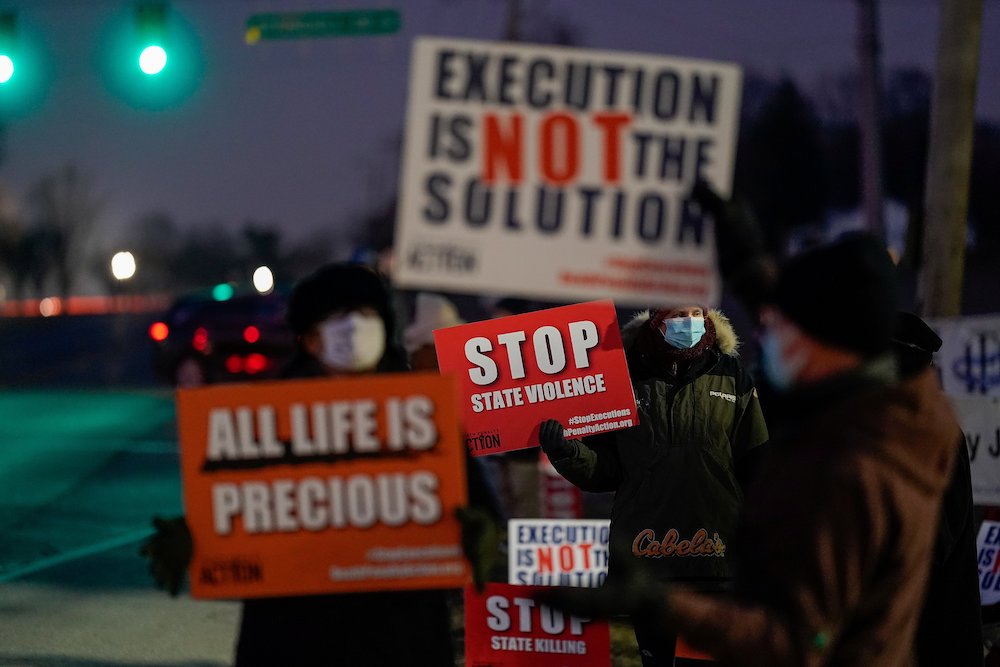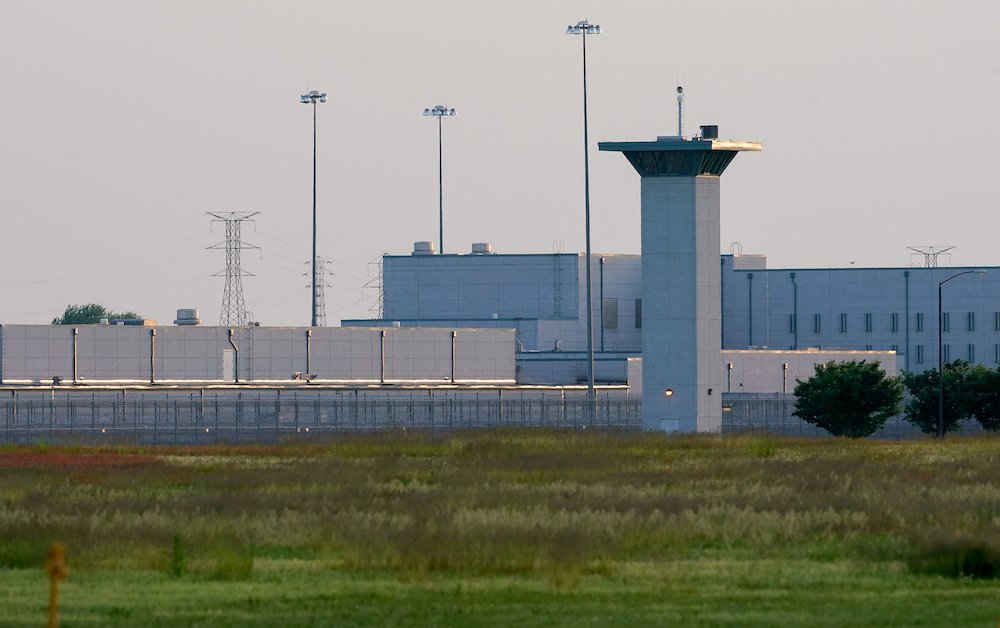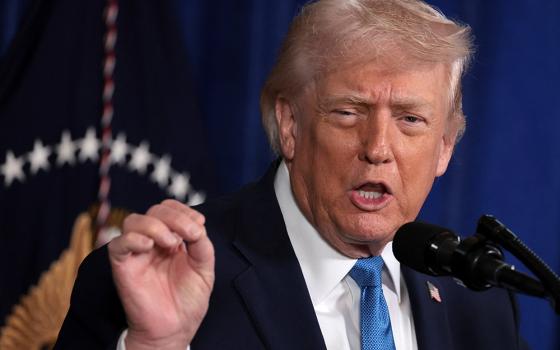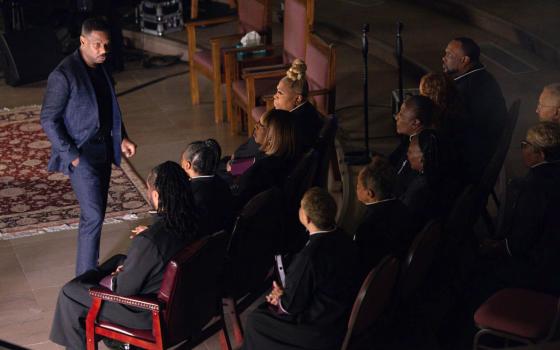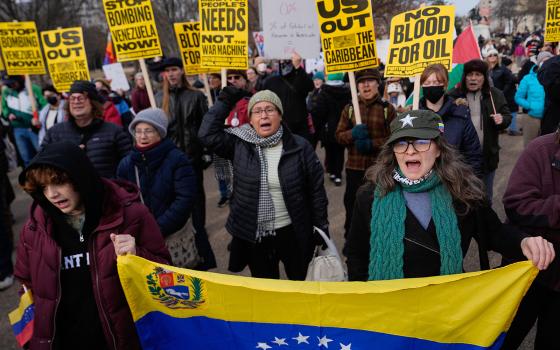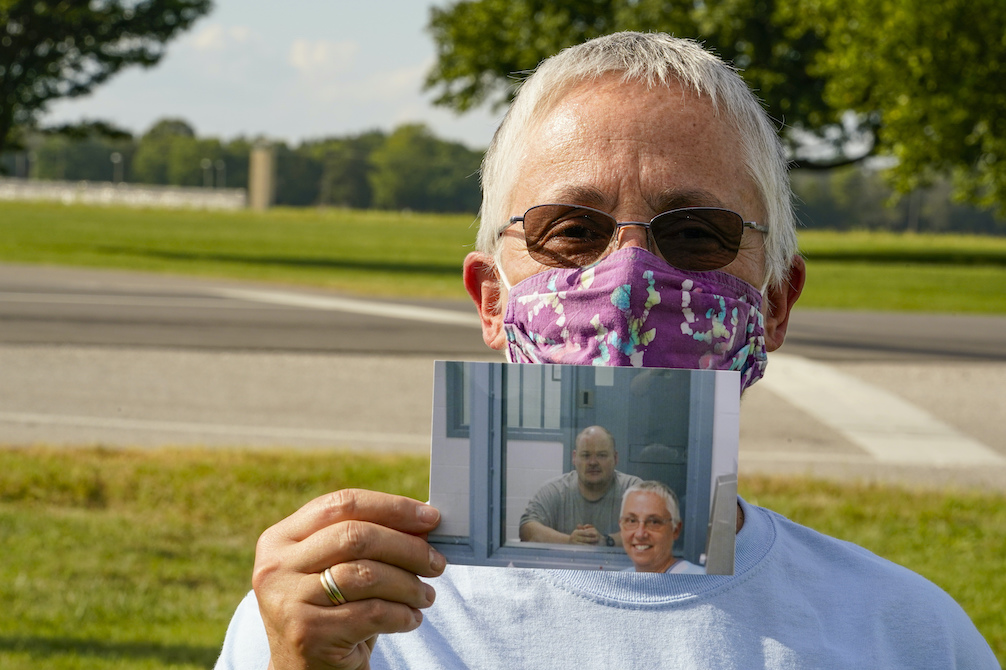
Providence Sr. Barbara Battista holds a photo taken during her last visit with Keith Dwayne Nelson, who was executed at the federal prison complex in Terre Haute, Indiana, Aug. 28, 2020. Battista was Nelson's spiritual adviser and was present as he was executed. (AP/Michael Conroy)
Sr. Barbara Battista wasn't in prison ministry and didn't visit the men incarcerated at the federal prison complex in Terre Haute, Indiana, like other Sisters of Providence of St. Mary-of-the-Woods.
But she was outspoken, and that's what Keith Dwayne Nelson wanted.
It was July 2020, and Nelson was scheduled to be the fifth person executed in a spree of 13 carried out by President Donald Trump and his attorney general, William Barr, between July 14, 2020, and Jan. 16, 2021.
Battista had been arrested at the U.S. Capitol a year before while protesting the administration's treatment of immigrant children and had been in the local press for that and other social justice actions over the years as the community organizer and justice promoter for her congregation.
More than a comforter, Nelson wanted a witness.
"He was very clear from the very beginning. He wanted me to tell the world what was going on in that [execution chamber]," Battista said. "It wasn't so much, 'Oh, say certain prayers' or 'Be there as a religious person.' ... Mostly, what he wanted was someone who would be willing to speak about it, to give them a glimpse of the horror and the violence and what really happens in there."
Nelson sent a request through another inmate and one of the sisters in the congregation's prison ministry: Would Battista accompany him to his execution?
After a 24-hour discernment process, she agreed.
"For a person to ask, a person in that situation — they're powerless against the state, the federal government," Battista said. "Everything in me wanted to say yes. ... I just couldn't imagine myself saying no."
Battista spoke to Nelson on the phone several times, and one week before his Aug. 28 execution, she visited him in person. While there, Nelson asked if she would consider accompanying a fellow death-row inmate: William Emmett LeCroy Jr. was scheduled to die Sept. 22 and was looking for a spiritual adviser.
Again, she said yes.
Advertisement
Inside the execution chamber
With the federal prison complex 10 miles away from the motherhouse, the Sisters of Providence have been involved in prison ministry for generations and have been working to abolish the death penalty for decades.
In 2001, after a 38-year hiatus, the federal government began executions again at its Terre Haute complex, and the fight took on a special urgency for the sisters. There were two executions in 2001 and one in 2003, then none until the series that began July 14, 2020, and included the deaths of Nelson and LeCroy.
Nelson was convicted of the 1999 kidnapping, sexual assault and killing of Pamela Butler, a 10-year-old Kansas girl. LeCroy was convicted of the 2001 rape and killing of Joann Tiesler, a 30-year-old Georgia woman.
Battista had agreed to accompany the men to their deaths but wasn't sure she could do it. Most of her career — nearly 40 years — had been spent working in medicine, working as a clinical oncology pharmacist and a physician assistant as well as in occupational medicine.
"I'm a health care provider, and I've been with people dying. I've been with them dying in a not-so-wonderful emergency situation, and I've been with our sisters, sitting in vigil and praying them home. But this was different," she said. "My question was: Could I actually stand there and watch a person being executed, being murdered by the state, and not instinctively reach out and pull out that IV tubing?"
Because of security restrictions and the tight timetable, Battista was only able to visit Nelson and LeCroy in person twice each; all other communication had to be by phone call or letter. When the execution dates came, the hours and procedures leading up to the lethal injections were highly orchestrated, and security was even tighter than usual in the maximum-security prison complex, Battista said.
Once in the death chamber, Battista couldn't help but notice that she was the only medical professional present for both executions.
"On the surface, it looks like a medical procedure. But as a medical professional, I can tell you there were no physicians, no physician assistants, no nurse practitioners, no nurses involved in that," she said. "It is totally against [the medical] code of ethics."
There was also no emotion, she said.
"It struck me how their faces, the U.S. marshal and the executioner, they are like robots, like stone," she said. "They're human beings, too, and I have to believe they are working hard to be in their mode. There's no emotion."
Battista said that is part of the stagecraft: All of the procedures and policies are designed to make the execution seem as sterile and detached as possible to hide what is actually extreme violence. Press accounts of the executions are at odds with official reports: Reporters present at the executions said the prisoners' stomachs "rolled, shook and shuddered" as they died, while official accounts said the inmates simply fell asleep and sometimes snored.
"It's in those moments of intense suffering through God's grace that we learn so much more about what's possible. Not only toward the suffering side, but what's possible in bringing about goodness."
—Sr. Barbara Battista
Most people assume executions are not public, Battista said, but in fact, the death chamber is surrounded on three sides by windows, with separate areas for members of the victim's family, members of the convicted person's family, and the press. Neither Nelson nor LeCroy had family present at their executions.
There are five people in the death chamber itself: the convicted person, the executioner at the left shoulder, a U.S. marshal at the right shoulder, the warden or the warden's representative, and the spiritual adviser if one is requested.
The prisoner is strapped to a table Battista describes as "cruciform," with their arms out wide.
"They were crucified. It was a public execution," she said.
Battista was not allowed to touch either man until he was pronounced dead.
"This is a man who's been in solitary confinement for 20 years, but there is no physical contact allowed with anyone but correctional officers," she said. "It's just another act of violence."
Nelson did not have any last words but asked Battista to give a message to his lawyers.
The executioner read from a script, which included the crimes for which Nelson was convicted, then picked up a phone — Battista did not know who the call was to — and asked if there were any impediments, such as a last-minute stay of execution. When there were none, the execution began. The IV tubing went through an opening in the wall to another room, so no one could see when the chemical began flowing.
"In Keith's case, it was quiet. No sound. ... No movement," she said. "And then it's over ... Now I can touch his body, so I start anointing him, praying the prayers of our church, praying him home. I anoint his chest, over his heart, and then I'm invited out."
There may have been no sound as Nelson died, but Battista was praying fervently. The Sisters of Providence have created a prayer service for executions, and Battista said those prayers to herself as Nelson's death sentence was carried out.
LeCroy, on the other hand, wanted something different. Though some press reports described him as "obsessed with witchcraft," Battista said LeCroy was very spiritual and studied the writings of Thomas Merton, C.S. Lewis and others. His last words, which he did not say at his execution but mailed to Battista, quote from W.H. Auden, Queen Elizabeth I, Samuel Richardson, Søren Kierkegaard, Kahlil Gibran, William Shakespeare and others.
"Will was very clear he wanted particular prayers, and he wanted them prayed out loud," Battista said. "He wanted the Divine Mercy Chaplet, which he wanted us to pray together, and then he wanted me to keep praying it out loud the whole time I was in the death chamber."
Nelson had been strapped down flat on the table, unable to see any of those watching, "another assault on his dignity," Battista said. So on the day LeCroy was to be executed, she asked the warden if the head of the table could be raised or if he could be given a pillow. When she arrived in the death chamber, she found the table had been tilted slightly so LeCroy could look around if he chose.
She told the executioner that LeCroy had requested that after they prayed together, that she keep praying aloud, but she said she would lower her voice while he was speaking.
When she spoke to LeCroy, she told him those protesting the execution outside the complex were eating Milk Duds — his favorite candy — in his honor, which made him chuckle.
Sr. Barbara Battista reads a letter Sept. 24, 2020, written by William LeCroy, who was executed two days earlier at the Federal Correctional Complex in Terre Haute, Indiana. (CNS/Criterion screenshot from Facebook livestream)
Then they prayed together, and Battista continued praying until LeCroy was pronounced dead. Then she anointed him as she had Nelson.
'More violence on top of violence'
Battista said she has seen many people die in her years in health care, but no other deaths affected her as profoundly as those of Nelson and LeCroy.
"It's a deeply spiritual experience, and I'm sure there's more that I will learn from this," she said.
Battista said many have said the coronavirus pandemic made 2020 a yearlong Lent, but for her, Lent began and ended with the string of 13 federal executions in seven months.
"It was just more harm, more violence on top of violence," she said. "It's the violence the person committed when they killed people, the violence that the family of the victims experience. So I felt — I still to this day feel — part of my mission, my ministry, is to be present to them, as well. Because they suffer."
Now, her prison ministry continues: She has offered to be in contact with other prisoners on death row, and she is working to create a fund to help family members make visits. And, of course, she continues advocating for the abolition of the death penalty.
In his final words, LeCroy quoted extensively from Merton, writing: " 'Let us be convinced of the fact we will never be anything else but beginners all our life.' I'm still learning still to be human. Still becoming a better human being. Because of Merton, I also exclaim, 'I love everybody. I am awakening from the dream of separateness.' "
Battista said she finds herself returning over and over to those words.
"Am I still learning? Am I still contemplating? Am I still experiencing the grief and the gift of being with Will? Yes," she said.
"I'm sure I'll continue to — it sounds odd to say 'reap the benefits of that,' but it is true. I believe that it's in those moments of intense suffering through God's grace that we learn so much more about what's possible," she said. "Not only toward the suffering side, but what's possible in bringing about goodness."

